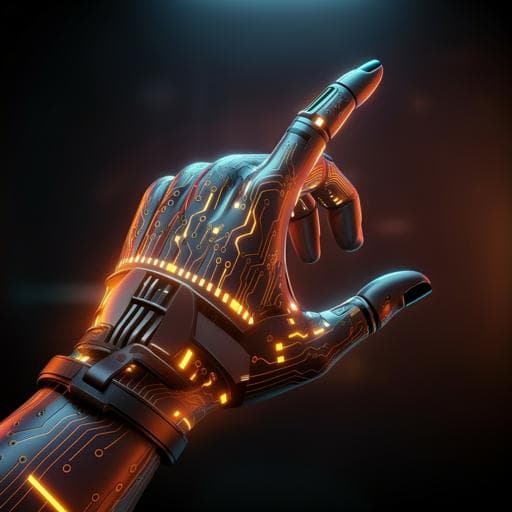
Engineering and Technology
Deep-learning-assisted printed liquid metal sensory system for wearable applications and boxing training
Y. Qiu, Z. Zou, et al.
Discover how a groundbreaking strategy using SiO₂ particles enhances liquid metal composites for superior sensory systems, achieving exceptional accuracy in recognizing boxing punches. This innovative research was conducted by Ye Qiu, Zhihui Zou, Zhanan Zou, Nikolas Kurnia Setiawan, Karan Vivek Dikshit, Gregory Whiting, Fan Yang, Wenan Zhang, Jiutian Lu, Bingqing Zhong, Huaping Wu, and Jianliang Xiao.
~3 min • Beginner • English
Introduction
The study addresses two key challenges in liquid-metal-based soft electronics: (1) achieving rapid, scalable patterning of liquid metals (LMs) despite their high surface tension, poor rheology, and limited wettability; and (2) improving the sensitivity of LM sensors, which typically rely on geometric change under strain and thus exhibit modest gauge factors (GF ≈ 2–6). Advances in flexible, stretchable electronics have created demand for high-performance, skin-mounted sensors capable of precise strain and pressure perception for health monitoring, wearable devices, and human–machine interfaces. The authors propose a strategy that modifies LM rheology by incorporating SiO₂ micro-particles and leverages strain redistribution mechanics to both enable direct 3D printing on soft substrates and significantly enhance sensor sensitivity, aiming to realize multifunctional, robust wearable sensing systems suitable for applications such as boxing training and motion recognition.
Literature Review
Prior efforts to improve LM processing and device performance have focused on modifying wetting characteristics and viscosity to simplify fabrication (e.g., avoiding lithography and reduction steps). Approaches include incorporating metal particles into LMs with acid treatment to remove oxides and enable homogeneous dispersion for better adhesion and direct writing, as well as sonication to distribute oxides within LMs to raise viscosity. However, these methods typically offer limited viscosity enhancement, hindering rapid prototyping and stable 3D patterning. On the sensing side, most LM-based strain sensors are piezoresistive with resistance changes dominated by geometry rather than intrinsic resistivity changes (LM resistivity remains nearly constant), which constrains gauge factors to roughly 2–6 in many reports, limiting applications requiring high sensitivity (e.g., skin prosthetics, humanoid robotics, wearable health monitoring). Multimodal decoupling strategies in literature include structural designs to minimize cross-sensitivity, distinct structural responses to pressure versus strain, or multisensor arrays with anisotropic conductive networks, but practical, scalable implementations with high sensitivity and robust mechanics remain an open need that this work seeks to address.
Methodology
Materials and composite preparation: The conductive LM was eutectic gallium–indium (eGaIn; Ga:In 75:25 wt%, melting point 15.7 °C). SiO₂ micro-particles (diameters: 6 µm and 40 µm) were mixed at 0, 1, 3.5, 6, and 20 wt% into eGaIn. Mixtures were stirred in air at room temperature at 500 rpm for 2 min and then 2000 rpm for 8 min to obtain uniform dispersions.
Rheology: Using an Anton Paar Physica MCR 301 rheometer (25 mm parallel-plate, Peltier plate, 25 °C), the following tests were performed: (1) preshear 120 s at 1 s⁻¹; (2) frequency sweep at 0.5% strain from 0.1–500 rad s⁻¹ to determine G′ and G″; (3) amplitude sweep at 1 rad s⁻¹ from 0.05–1000% strain to determine linear viscoelastic region and oscillation yield stress; (4) flow sweep from 0.01–10 s⁻¹ for shear-rate-dependent viscosity. Rheological trends versus SiO₂ loading and particle size (6 µm vs 40 µm) were quantified.
3D printing: Composites containing 1 wt% 6 µm SiO₂ were dispensed using a modular 3D printer (Hyrel 3D Hydra 640) with a motorized 10 mL syringe extruder. Nozzles: 15 Ga for star structures, 22 Ga for sensor traces. Printing speed: 10 mm s⁻¹; layer height: 0.7 mm. One-layer and four-layer star geometries were demonstrated. Strain sensors were directly printed on a tactile glove over the first knuckle of each finger (trace width ≈ 0.6 mm; length 20 mm; 22 Ga nozzle; 10 mm s⁻¹).
Sensor fabrication: Ecoflex substrate (Ecoflex Supersoft 0030, 1:1 A:B) was spin-coated on glass (1500 rpm, 30 s) and cured at 80 °C for 30 min. LM–SiO₂ wires were printed onto the substrate, copper leads attached, and an Ecoflex encapsulation layer was added and cured (80 °C, 30 min). Samples were cut into 40 × 20 × 1 mm strips and peeled. Electrical signals were measured with a Keithley 4200-SCS.
Mechanical/electrical testing: Tension and compression tests used an Instron LEGEND2345. Tensile speed: 240 mm min⁻¹ for monotonic and cyclic tests; 100 cycles at 100% strain. Compression speed: 2 mm min⁻¹; cyclic compression: 100 cycles at 100 kPa. Strain sensing metrics included gauge factor, minimum detectable strain, response time, hysteresis, and cycling stability. Pressure sensing assessed ΔR/R versus pressure and maximum survivable pressure before LM channel collapse.
Finite element analysis (FEA): ABAQUS was used to model deformation and strain redistribution. Ecoflex was modeled with a Yeoh hyperelastic model (C10 = 0.0104 MPa, C20 = 0.0072 MPa, C30 = 0.012 MPa; fit to uniaxial test), LM as Neo-Hookean with C10 = 0.5 kPa (shear modulus 1 kPa). 3D hybrid stress elements (C3D8H) were used for elastomers. SiO₂ particles (Young’s modulus 76 GPa, ν = 0.3) were modeled as elastic isotropic (C3D8R) and embedded uniformly within LM wires via constraints to study strain localization and conductive path narrowing under tension. Simulations compared pure LM vs LM–SiO₂.
Deep learning for boxing recognition: A tactile glove with printed multisensory arrays captured finger strain during clenching and pressure during impact. For recognition, only the middle-finger resistance signal was used to simplify inputs. A CNN (implemented in PyTorch) with two convolutional layers (Conv1: 64 filters, kernel size 3, stride 1; max-pooling k=2, s=2; Conv2: 5 filters, kernel size 3, stride 1), followed by flattening and output layer, was trained. Dataset: 150 sets (30 sets per punch class), split 90% training and 10% testing. Preprocessing included scaling and normalization. Classes encompassed jab, swing, uppercut, and combination punches; classification performance was evaluated via a confusion matrix.
Key Findings
- Rheology and printability: Adding SiO₂ significantly increased elastic modulus, yield stress, and viscosity of eGaIn composites, with 40 µm particles yielding stronger effects than 6 µm at equal wt%. The enhanced yield stress/viscosity allowed the extruded composite to retain shape, enabling stable 3D printing on soft substrates (demonstrated one-layer and four-layer printed stars).
- Strain sensing sensitivity: Pure LM sensors showed linear ΔR/R with strain and GF = 2.41. Incorporating 40 µm SiO₂ increased GF to 3.01 (1 wt%) and 4.72 (3.5 wt%). At 6 wt% (40 µm), the response became highly nonlinear at high strains with an effective GF of 14.65 over 200–300% strain. Using large SiO₂ particles (~0.6 mm, comparable to channel width), the GF was 5.72 (0–100%), 11.63 (100–200%), and 23.91 (200–300%), nearly 10× the pure LM sensor at high strains.
- Mechanism: FEA showed uniform strain in pure LM wires versus pronounced strain redistribution and localized channel narrowing in LM–SiO₂ composites, explaining the rapid resistance increase and sensitivity enhancement at large strains.
- Resolution and dynamics: Minimum detectable strain was 0.05% with response time of 158 ms. Hysteresis was low (≈1.4%) even at 300% strain. Sensors remained stable over 100 stretch–release cycles at 100% strain.
- Wearable strain sensing demos: Real-time decoding of human motions at eye, finger, neck, and knee with clear, posture-dependent piezoresistive signals.
- Pressure sensing and robustness: ΔR/R increased with pressure; maximum withstand pressure before failure increased from 696.3 kPa (pure LM) to 981.5 kPa (6 wt% SiO₂). The sensor exhibited reversible behavior over 100–300 kPa and durability over 100 compression cycles at 100 kPa.
- Gait/plantar sensing: Foot-mounted sensors distinguished shaking leg, walking, running, and tiptoeing via distinct pressure signal profiles.
- Tactile glove for boxing: Sensor arrays on a glove decoded correct vs incorrect fist-clenching postures and tracked punching strength (monotonic increase in signal with applied pressure), with reversible, repeatable responses across punch–release cycles.
- Deep-learning recognition: Using only the middle-finger signal, a CNN achieved 90.5% classification accuracy across five punch types (including single and combination punches), as shown by the confusion matrix.
Discussion
The work addresses the dual challenge of LM sensor manufacturability and sensitivity. Rheological modification via SiO₂ microparticles overcomes high surface tension and poor wettability by increasing viscosity and yield stress, enabling direct, scalable 3D printing of stable LM traces on soft substrates. Simultaneously, the inclusion of SiO₂ redistributes strain within LM channels under tension, producing localized narrowing and pronounced increases in resistance at large strains, which boosts gauge factors far beyond those of pure LM sensors. The sensors exhibit low hysteresis, wide strain range (up to 300%), and improved pressure endurance, supporting robust performance under diverse mechanical stimuli. These advances translate into practical wearable applications: real-time motion decoding on the body, plantar pressure differentiation for gait patterns, and a tactile glove that decouples clenching (strain) from impact (pressure) to monitor technique and strength in boxing. Assisted by a CNN, the system reliably recognizes multiple punch types with high accuracy, demonstrating the potential of printed LM sensory systems for smart sport training, soft robotics, and human–machine interfaces.
Conclusion
The study demonstrates a printable LM–SiO₂ composite sensing platform that combines enhanced processability with high sensitivity and robustness. SiO₂ additives substantially improve LM rheology to enable 3D printing, while strain redistribution around particles elevates strain sensitivity (GF ≈ 5.72, 11.63, and 23.91 over 0–100%, 100–200%, 200–300% ranges with large particles) and increases pressure tolerance to nearly 1 MPa. Integrated into a tactile glove, the sensors decode fist-clenching postures and punching strength and, with CNN assistance, classify punch types with 90.5% accuracy. Future work includes integrating sensor arrays with onboard signal processing and wireless modules for untethered monitoring, and advancing array structural designs to better decouple and recognize multidimensional strain/pressure stimuli from various directions.
Limitations
- Signal usage for recognition was limited to a single channel (middle-finger resistance) to simplify analysis, which may not capture the full multimodal richness available from all fingers and pressure sensors.
- The boxing dataset comprised 150 sets (30 per class) with a 90/10 train/test split, which may limit generalizability; larger, more diverse datasets and subjects are needed.
- Current demonstrations relied on benchtop instrumentation; integration with compact signal processing and wireless transmission is identified as future work.
- While pressure tolerance improved (to ~0.98 MPa), LM channel collapse defines an upper bound on detectable pressure; design optimization is needed for higher-range applications.
- Decoupling and recognition of multidirectional, simultaneous strain and pressure inputs remain open challenges highlighted by the authors for future sensor array designs.
Related Publications
Explore these studies to deepen your understanding of the subject.







